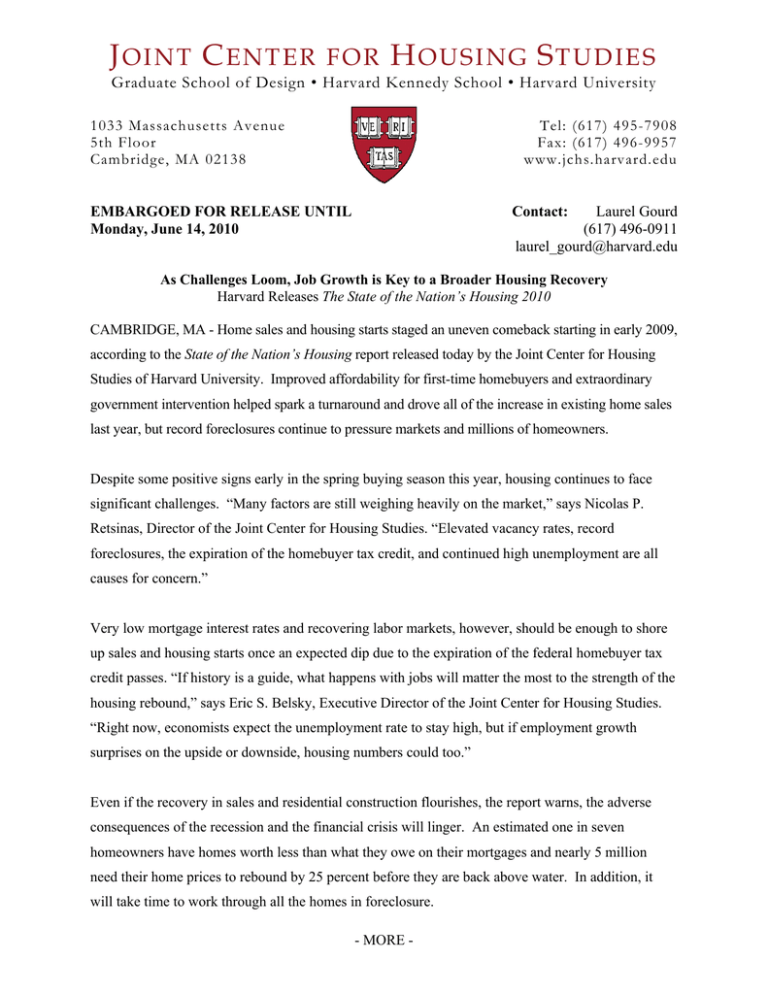J C H S
advertisement

JOINT CENTER FOR HOUSING STUDIES Graduate School of Design • Harvard Kennedy School • Harvard University 1033 Massachusetts Avenue 5th Floor Cambridge, MA 02138 Tel: (617) 495-7908 Fax: (617) 496-9957 www.jchs.harvard.edu EMBARGOED FOR RELEASE UNTIL Monday, June 14, 2010 Contact: Laurel Gourd (617) 496-0911 laurel_gourd@harvard.edu As Challenges Loom, Job Growth is Key to a Broader Housing Recovery Harvard Releases The State of the Nation’s Housing 2010 CAMBRIDGE, MA - Home sales and housing starts staged an uneven comeback starting in early 2009, according to the State of the Nation’s Housing report released today by the Joint Center for Housing Studies of Harvard University. Improved affordability for first-time homebuyers and extraordinary government intervention helped spark a turnaround and drove all of the increase in existing home sales last year, but record foreclosures continue to pressure markets and millions of homeowners. Despite some positive signs early in the spring buying season this year, housing continues to face significant challenges. “Many factors are still weighing heavily on the market,” says Nicolas P. Retsinas, Director of the Joint Center for Housing Studies. “Elevated vacancy rates, record foreclosures, the expiration of the homebuyer tax credit, and continued high unemployment are all causes for concern.” Very low mortgage interest rates and recovering labor markets, however, should be enough to shore up sales and housing starts once an expected dip due to the expiration of the federal homebuyer tax credit passes. “If history is a guide, what happens with jobs will matter the most to the strength of the housing rebound,” says Eric S. Belsky, Executive Director of the Joint Center for Housing Studies. “Right now, economists expect the unemployment rate to stay high, but if employment growth surprises on the upside or downside, housing numbers could too.” Even if the recovery in sales and residential construction flourishes, the report warns, the adverse consequences of the recession and the financial crisis will linger. An estimated one in seven homeowners have homes worth less than what they owe on their mortgages and nearly 5 million need their home prices to rebound by 25 percent before they are back above water. In addition, it will take time to work through all the homes in foreclosure. - MORE - Despite falling home prices, loan modifications, and softening rents, the downturn did not reduce the number of households spending half or more of their income on housing—18.6 million in 2008. Instead, the share with such severe housing cost burdens climbed to a new height. Both housing policy challenges and opportunities will abound in the years ahead. Chronic housing affordability problems and the long tail of the foreclosure crisis are major concerns, but housing offers some excellent opportunities for energy savings as the nation strives to reduce carbon emissions. “Not only can new green building standards and innovative architectural designs help reduce energy consumption in the next generation of homes, there are opportunities to wring major savings out of the existing housing stock,” said Mohsen Mostafavi, Dean of the Harvard University Graduate School of Design. “Today’s homeowner has the ability to significantly reduce home energy costs through environmentally-conscious building materials and design approaches.” Indeed, after adjusting for degree days, energy consumption per square foot of housing built before 1990 fell by 22 percent from 1993 to 2005 largely as a result of improvements, and this could be trimmed even more if these homes were brought up to the same efficiencies as those built in the 2000s. Over the coming decade and once employment stages a convincing comeback, demographic forces should lift currently depressed levels of household growth and spur increased construction and sales. Bolstered by immigrants, the echo-boom generation is already larger than the baby boom generation, and the baby-bust generation (born 1966-1985) is nearly as large. If immigration matches the pace projected by the Census Bureau and headship rates by age and race hold steady, household growth should come close to 15 million from 2010 to 2020. Even if it falls to half the projected pace, household growth should equal the 12.5 million growth from 1995-2005. The State of the Nation’s Housing, released annually by the Joint Center for Housing Studies, provides a periodic assessment of the nation’s housing outlook and summarizes important trends in the economics and demographics of housing. The report continues to earn national recognition as a source of information regularly utilized by housing researchers, industry analysts, policy makers, and the business community. The Joint Center for Housing Studies is Harvard University’s center for information and research on housing in the United States. Established in 1959, it is a collaborative unit affiliated with the Graduate School of Design and the Harvard Kennedy School. The Joint Center analyzes the dynamic relationships between housing markets and economic, demographic, and social trends, providing leaders in government, business, and the non-profit sector with the knowledge needed to develop effective policies and strategies. For more information, please visit www.jchs.harvard.edu. - END -


